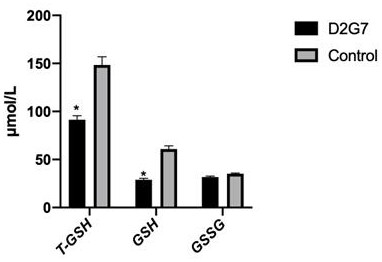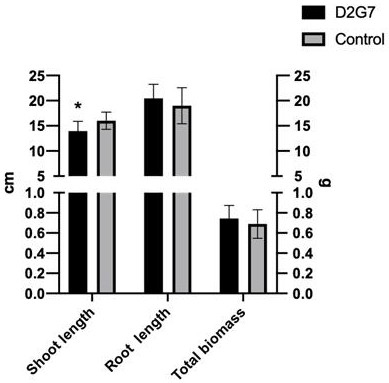Plant endophytic fungus phomopsis D2G7 and application thereof
A technology of plant endophytic fungi, Phomopsis, applied in plant growth regulators, plant growth regulators, applications, etc., can solve problems such as physical health threats, hindering plant root respiration, and affecting plant growth and development
- Summary
- Abstract
- Description
- Claims
- Application Information
AI Technical Summary
Problems solved by technology
Method used
Image
Examples
Embodiment 1
[0029] Example 1: Isolation, screening and identification of Phomopsis D2G7
[0030] A. Collect the plant samples of Nepeta nepeta, the dominant plant in the slag area of the heavy metal polluted land, and rinse them under tap water;
[0031] B. Divide the plant sample into three parts: roots, stems and leaves, and carry out surface disinfection respectively. First, soak in ethanol solution with a volume concentration of 75% for 3 to 5 minutes, rinse with sterile water for 3 to 5 times, and then use available chlorine with a concentration of 5%. Soak in sodium hypochlorite solution for 2 to 3 minutes, rinse with sterile water for 3 to 5 times, and place it on sterile filter paper to absorb the water after rinsing; cut the root, stem, and leaf tissue pieces into fragments and paste them on a tissue containing 0.5g / Cultivate on the PDA medium of L streptomycin sulfate and 0.5g / L penicillin, culture at 24-26°C for 40-50 days, observe the next day, pick if there are colonies gr...
Embodiment 2
[0038] Example 2: Research on the Effect of Phomopsis D2G7 on the Accumulation of Low Concentration Heavy Metals
[0039] This example aims to prove that the filamentous fungus D2G7 provided by the present invention promotes plant growth and plant heavy metal pollution restoration in heavy metal pollution; Dysphania ambrosioides ) is the test plant, and the experimental process is as follows:
[0040] A. Preparation of sterile seedlings of Nepeta nepeta: The seed samples of Nepeta nepeta were collected on August 10, 2018 at the abandoned slag pile next to Sanduoduo Village, Zhehai Town, Huize County (26°28′17″ north latitude, 103 east longitude °37′34″, 2273 m above sea level), stored at 4°C for later use, randomly selected a few nepeta seeds from soil, and carried out surface disinfection according to the following procedures: first soak in 75% ethanol solution for 3 minutes, rinse with sterile water for 4 Then soak in NaClO solution with an effective chlorine concentration...
Embodiment 3
[0056] Example 3: Effects of Phomopsis D2G7 on the growth of Nepeta nepetae under low-concentration heavy metal stress
[0057] Experimental process and technical method are the same as embodiment 2, and difference is during the growth period of Nepeta nepeta, increased the mensuration of nepeta seedling biomass; Transplanting nepeta nepeta seedlings harvested the 46th day, measured strain Height, root length, dry weight, MDA, chlorophyll, glutathione GSH, etc.; GSH=T-GSH-2GSSG to calculate GSH content;
[0058] The results of the pot experiment figure 2 , 3 , 4 showed that the treatment group inoculated with Phomopsis D2G7 increased the root length, dry weight and chlorophyll content of Nepeta nepeta by 6.02%, 4.34% and 4.37%, respectively. However, the plant height, T-GSH, GSH and GSSG contents of the treatment group decreased by 9.93%, 38.41%, 52.48% and 14.71%, respectively. Among them, plant height, chlorophyll, T-GSH and GSH had significant differences between the ex...
PUM
 Login to View More
Login to View More Abstract
Description
Claims
Application Information
 Login to View More
Login to View More - R&D
- Intellectual Property
- Life Sciences
- Materials
- Tech Scout
- Unparalleled Data Quality
- Higher Quality Content
- 60% Fewer Hallucinations
Browse by: Latest US Patents, China's latest patents, Technical Efficacy Thesaurus, Application Domain, Technology Topic, Popular Technical Reports.
© 2025 PatSnap. All rights reserved.Legal|Privacy policy|Modern Slavery Act Transparency Statement|Sitemap|About US| Contact US: help@patsnap.com



